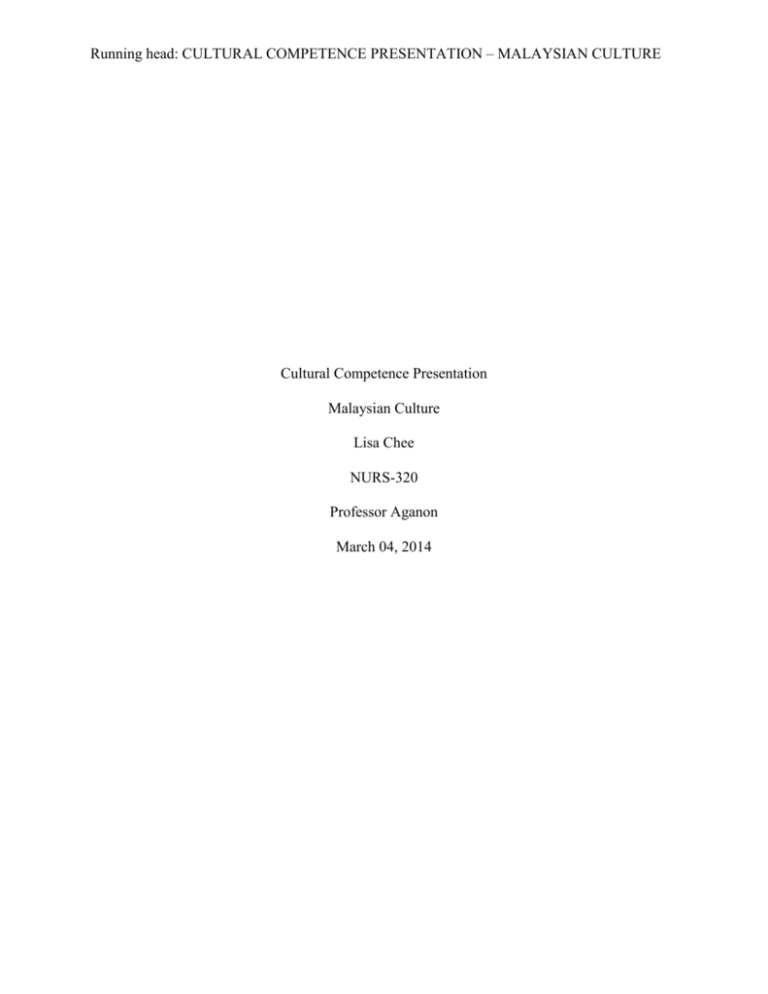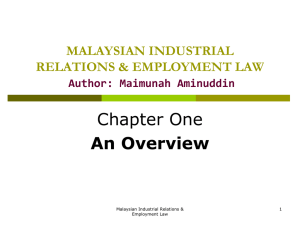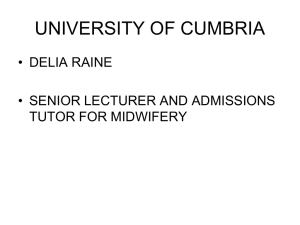File
advertisement

Running head: CULTURAL COMPETENCE PRESENTATION – MALAYSIAN CULTURE Cultural Competence Presentation Malaysian Culture Lisa Chee NURS-320 Professor Aganon March 04, 2014 CULTURAL COMPETENCE PRESENTATION – MALAYSIAN CULTURE 2 According to the 2010 United States (U.S.) census bureau, the Asian race was one of the fastest growing populations in the U.S. over a 10 year period, between 2000 to 2010 (United States Census Bureau, 2012). The U.S. census bureau defined the term ‘Asian’ as individuals with origins from the Far East, Southeast Asia, or the Indian subcontinent (e.g. Cambodia, China, India, Japan, Korea, Malaysia, Pakistan, the Philippine Islands, Thailand and Vietnam). Specifically in the U.S., Hawaii (0.8 million) tied for 4th, alongside New Jersey (0.8 million), to have one of the fastest growing Asian populations; behind California (5.6 million), New York (1.6 million) and Texas (1.1 million). Thus, with the rapid growing Asian population in the U.S., I decided to focus my cultural competence presentation on the Indian subcontinent, particularly Malaysia, in regards to their culture and customs surrounding pregnancy, childbirth, postpartum period and care of the newborn. During the antepartum period, pregnant Malaysian women carry out certain ceremonies and practices. According to the National Department for Culture and Arts (2013), ceremonies are performed to pray for the safety of the mother and her fetus and to ensure that both parties will be healthy and protected from any misfortunes. There are five common cultural practices in which Malaysian women will engage in prior to the birth of her baby. These five practices include: Booking the midwife (Menempah Bidan), touching the stomach (Menjamah Perut), rolling the stomach (Melenggang Perut), bathing the stomach (Mandi Melenggang Perut) and consulting the spirits (Mengadap Semangat). The first cultural practice, ‘Booking the Midwife (Menempah Bidan),’ is carried out by the mother-in-law and completed when the woman is about 7 months pregnant, typically only if it is her first pregnancy. This practice is crucial as it ensures that a reliable and responsible midwife will be present during the birth of the baby. Malaysians believe that the best day to book CULTURAL COMPETENCE PRESENTATION – MALAYSIAN CULTURE 3 a midwife is on a Thursday, preferably towards the end of the month, between the 21st and 29th day of the Muslim calendar. Contrarily, Malaysians believe that the worst day to book a midwife is Tuesday. After successfully booking a midwife, the mother-in-law would change the curtains, decorate the house, and invite relatives to visit (National Department for Culture and Arts, 2013). The second cultural practice, ‘Touching the Stomach (Menjamah Perut),’ is performed by the midwife. First, the midwife would apply oil to the pregnant woman’s stomach and provide massages. This practice is performed to correct the position of the fetus. Subsequently, she would ask for blessings by reciting the mantras three times in the name of the Holy Prophet (National Department for Culture and Arts, 2013). The third cultural practice, ‘Rolling the Stomach (Melenggang Perut),’ is performed by the midwife as well. She will roll a coconut (with the outer layer peeled) onto the pregnant woman’s stomach, towards her legs. This practice is performed to ensure a smooth and easy childbirth. When the coconut reaches the pregnant woman’s legs, she is instructed to give the coconut a hard kick. It is believed that if the “eyes” of the coconut turns upwards when the coconut stops rolling, then the baby will be a boy. An egg is also rolled onto the woman’s stomach. This practice is believed to ward off evil spirits. Using a spoon, she will also place rice flavored with turmeric (nasi kunyit) onto her stomach. This cultural practice is also used to ward off evil spirits. Lastly, the spoon will be rubbed onto the pregnant woman’s stomach. Malaysians believe that this practice will make the newborn’s face pretty and smooth (National Department for Culture and Arts, 2013). The fourth cultural practice is ‘Bathing the Stomach (Mandi Melenggang Perut)’. Prior to bathing the stomach, the midwife will once again ask for blessings by reciting the mantras in the name of the Holy Prophet. The pregnant woman will then wear a sarong above her bosom as the CULTURAL COMPETENCE PRESENTATION – MALAYSIAN CULTURE 4 midwife, assisted by several other individuals, bathe her with water from seven different wells and sprinkle her with seven different types of flowers. Finally, the midwife will trim the hair of the pregnant women. Malaysians believe that this will ensure that the newborn baby will not be hairy (National Department for Culture and Arts, 2013). Last but not least, the fifth cultural practice Malaysian’s engage in during antepartum is ‘Consulting the Spirits (Mengadap Semangat)’, a ceremony which is only attended by women. Prayers and food offerings (e.g. white rice, nasi kunyit, eggs and fruits) are made to the spirits to ensure that the baby will be physically normal, without any handicap (National Department for Culture and Arts, 2013). During the antepartum period, Malaysian women also have certain taboos in their culture, where engaging in certain actions will lead to negative outcomes. For example, Malaysian women are prohibited from hearing, seeing or speaking about negative things that may frighten her. This is to ensure that the pregnant women will be happy throughout her pregnancy and give birth to a happy, healthy, non-handicapped baby. They believe that the pregnant woman should not laugh, insult or make fun of other people’s imperfections, as these characteristics will be found in her newborn. Also, they are not allowed to bathe after Maghrib and Isyak prayer time, nor soak her clothes overnight, as it is believed that by doing so will cause the woman’s body to be bloated during childbirth. Lastly, the pregnant woman is prohibited from putting out the embers of any fires due to the belief that the newborn baby will have a dark future (National Department for Culture and Arts, 2013). During the intrapartum period, Malaysian women are encouraged to pray during labor and to avoid crying and screaming (Queensland Health, 2009). They prefer to be seen by a CULTURAL COMPETENCE PRESENTATION – MALAYSIAN CULTURE 5 female practitioner and choose to maintain their modesty at all times, being protected by either a curtain or screen. They are familiar with hospitals and usually deliver there. Upon delivery of the newborn, the midwife is responsible for cutting the umbilical cord with scissors that have been ‘blessed’. In addition, Malaysian’s bury their placenta at the front door of their home, along with tamarind, salt, needles, books and pencils, to ensure that their baby will grow up to be a hardworking child and a smart student. However, the placenta is not to be buried at 12 noon sharp or buried too deep, as it is believed that the baby will be stubborn or have a delayed speech development (National Department for Culture and Arts, 2013). During the postpartum recovery period, Malaysian women usually engage in a period of confinement, ranging from 30-45 days, where the female will remain at home and partake in cultural practices to restore body heat that was lost during childbirth. Similar to other Asian cultures, Malaysians believe in the concept of “hot and cold,” where the body is “cold” after childbirth, and one must eat “hot” foods. Thus, a Malaysian woman’s postpartum diet will strictly consist of hot food items, omitting foods such as fruits, vegetables and cold drinks. In particular, Malaysian women will drink jamu, an herbal drink made with turmeric, because they believe that it will relieve painful cramps and prevent rheumatism (Queensland, 2009). Last but not least, the following are cultural practices for Malaysian’s in terms of caring for their newborn. According to Islamic tradition, boys may be circumcised at any time from seven days; however, in Malaysia, boys are usually circumcised when they are around seven or eight years old. In regards to feeding, breastfeeding mothers usually express their colostrums prior to initiating breastfeeding. During the time period (1-2 days) that the colostrum is being expressed, newborns are substituted with liquid nutrition (e.g. a mix of corn flour and water). Unlike the American culture, where breastfeeding is heavily emphasized and prolonged until the CULTURAL COMPETENCE PRESENTATION – MALAYSIAN CULTURE newborn is at least six months of age, Malaysian culture begins supplementing breast milk with food (e.g. thinned rice water, cow milk or formula) as early as the newborns first month of age. In conclusion, Malaysian’s have a wide range of cultural practices and beliefs in regards to antepartum, intrapartum, postpartum phases of pregnancy, as well as newborn care. A nurse caring for a patient with a Malaysian decent may want to include an evidence based teaching plan regarding the importance of feeding colostrum to her newborn, as well as the benefits of breastfeeding her infant till at least six months of age before introducing supplemental formula (e.g. breastfeeding their newborn will reduce the risk of infection for baby and will promote uterine involution and reduce postpartum bleeding for the mother). 6 CULTURAL COMPETENCE PRESENTATION – MALAYSIAN CULTURE 7 References National Department for Culture and Arts (2013). Malay Community. Web. Retrieved on March 01, 2014 from http://www.jkkn.gov.my/en/malay-community. Queensland Health (2009). Multicultural Clinical Support Resource- Cultural Dimensions of Pregnancy, birth and Post-Natal Care. Web. Retrieved March 01, 2014 from http://www.health.qld.gov.au/multicultural/support_tools/14mcsr-pregnancy.pdf. United States Census Bureau (2012). The Asian Population: 2010. Web. Retrieved on March 01, 2014 from https://www.census.gov/prod/cen2010/briefs/c2010br-11.pdf.






